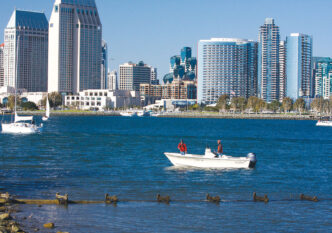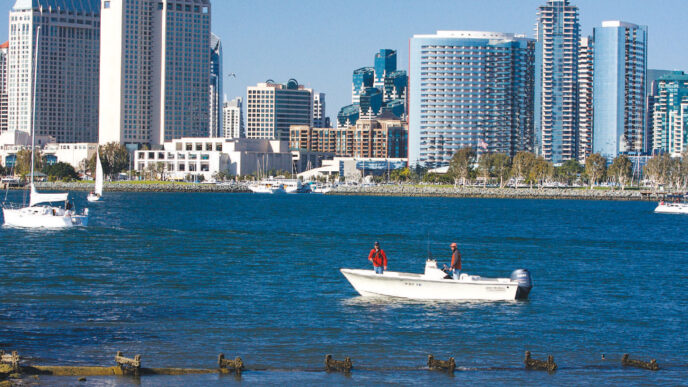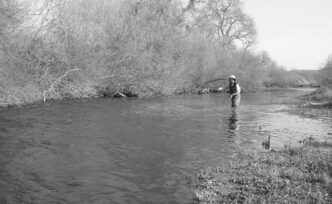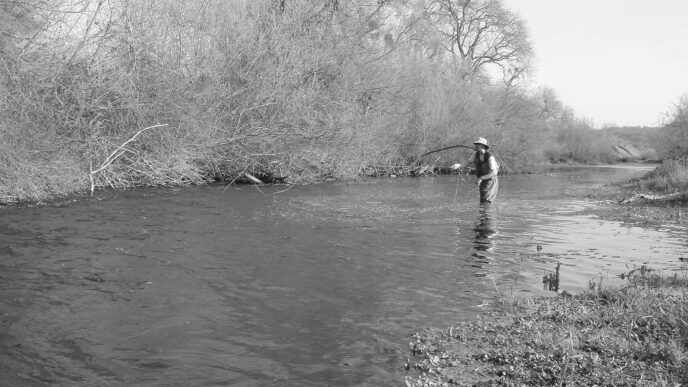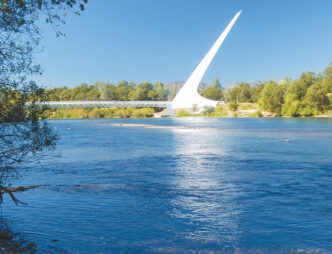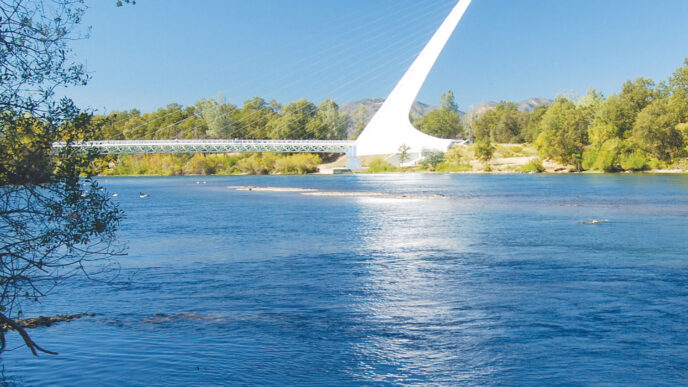Better Hamburgers at Home or in Camp
With Trent Pridemore
I’ve had a lifelong lust for good hamburgers. Even though I have experienced a lot of fine dining, I still relish a great burger. Perhaps the passion came from my dad, whose favorite food was the hamburger. He was a writer later in life and did a piece that looked at reconstructing a burger remembered from his youth, using “gourmet” ingredients. He said that his first restaurant meal was a burger. His last meal in a restaurant was the same, at a lakeside place in the mountains where waves lapped the shoreline and there was a great view.
The setting and the company that surround any meal matters and can only complement an already good thing. That’s why burgers in a backyard, park, or at streamside or lakeside are the best in the world. About the only downside that I can see about a lake or streamside burger dinner is that really good burgers are juicy and might mess up a new fishing shirt.
Dad did a good job in that article. I’ve taken his thoughts and added them to some of my burger experiences over the years. One was early on, when I was paying for college by working as a timber cruiser on California’s Lost Coast. We burned thousands of calories going cross-country through rugged coastal mountains on our survey lines. Our camp cook, Jewel, worked hard to come up with meals that would give our crew members enough energy and stamina to run our timber surveys. Cholesterol readings weren’t included in lab results in those days. On the weekly dinner menu, between half of a roasted chicken with biscuits and gravy and a one-pound chicken-fried steak, was the “Jewel Burger.” Jewel was a very large man and had been a champion California state weight-lifter in the heavyweight class. A set of weights lay on the forest floor next to Jewel’s outdoor kitchen. His Jewel Burger patties weighed in at three-quarters of a pound, and he offered seconds.
Jewel knew the basics of a good burger. The beef grind that he got f rom a butcher in Eureka had a lean-to-fat ratio of somewhere around 80/20. He had a secret seasoning mixture and baked up man-sized, camp-made buns for those big patties in a wood-burning oven just before dinner. His beef patties were hand-formed with a light touch, and they always had a slight depression in the center so they would puff up level as they cooked, giving his condiments a place to sit. He cooked in huge cast-iron skillets and avoided compressing his burger patties with the back of a spatula. He turned them only once to preserve the delicious caramelized crust that was complemented by his spice rub. He would give a tired timber cruiser a medium or well-done burger only reluctantly. His favorite was medium rare, served on a wooden plank table overlooking Pecwan Riffle on the Klamath. After dinner, we would wet wade until dark, throwing flies to half-pounders of another kind. For several years, my wife, Karen, and
I hosted a burgers-and-zinfandel night for the Sierra Grape Growers and Vintners of Nevada County. It evolved out of my desire to emphasize our belief that wine and food are inseparable and synergistic and that a special burger paired with a great red wine is one of the ultimate dining experiences. Zinfandel works well with spicy, grilled meats, but our grape growers bring their favorite reds — straight varietals such as syrah, barbera, and cabernet, as well as tasty blends. We have a long bar made from black-oak planks suspended on two wine barrels. Thirty or so bottles of red could appear, and we were able to taste and form opinions on what goes best with the hamburgers. The event was held in the early fall, after an always frantic grape crush, when our members and their friends could finally take a break from the end-of-the-season labor.
For these dinners, I searched for the perfect burger bun, and I found it in two places. One was in Sacramento at Ettore’s European Restaurant and Bakery. Their bun had baked-in cheese elements and sold for $1.00. It was very good and won accolades in the Sacramento Bee’s bestburger contest several years ago. The problem was that to get buns the same day as the event, I had to drive an hour and fifteen minutes each way. That didn’t work.
I also tried some small local bakery products and wasn’t happy. Then I stumbled on a better choice . . . a local SaveMart supermarket that offered bulk buns for $.34 apiece or three for a dollar, every day. They baked them in lots of fifty or more in the morning, perfectly timed for my evening event. It was — and is — a large, tasty bun and holds together when assaulted with juice from condiments and a rich burger patty. I would pick them up while they were still warm, around two in the afternoon, and I’d be fabricating burgers patties by five and cooking by seven. I found that this bun also travels well when sealed in a clear plastic produce bag, coming out fresh days later. The bun worked fabulously for the burgers-and-zin evening, but is also perfect for camping.
If I can’t get these, which is almost never the case, I buy potato buns, which stay soft for a number of days and complement just about any burger. Perhaps the best choice, though, is a fresh, homemade bun that comes right out of the oven. I am experimenting this year with pizza-dough buns baked on a stone under the grill’s hood. My wife and I tried a number of gourmet burger recipes, including a guacamole burger, but we’ve settled on two that have been our guests’ favorites. One is a blue cheese and caramelized onion burger . . . nothing else. The other is America’s favorite — an American cheeseburger made with high-grade Wisconsin white cheddar, iceberg lettuce, sweet red onions, tangy beefsteak tomatoes, Dijon mustard, and mayonaisse.
Forty-five grape growers and vintners can eat about 60 burgers, along with a salad of California garden greens and mesclun and a big bowl of olive-oil potato chips. I could always tell the favored wines when I cleaned up in the morning. If a bottle was still half full, it didn’t make the grade. The leftovers went in our vinegar barrel, but I never told whose wine was not a favorite, and we had dynamite red wine vinegar all year long.
My local butcher shop doesn’t buy ground meat from a distributor. It makes its own from high-quality trimmings, and the product includes pieces of filet, rib eye, chuck, New York, and other steaks. It makes lean, standard, and fatty blends. I often use their 80/20 blend for my burgers. The 90/10 is too lean and cooks up dry. Use too much fat beyond 80/20, though, and you risk marring the taste of the burger. Renowned Iron Chef Bobby Flay, who won a big “Burger Fest” competition on TV, recommends an 80/20 ground chuck blend in his Mesa Grill cookbook. Some chefs like a fat content as high as 30 percent, but I find that the greasy flavor of this much fat detracts from the flavor of high-quality meat. Who knows if you are actually getting an exact 80/20 blend every time, though. Such precision is hard to provide consistently in a butcher shop.
Our local Gold Country Fly Fishing Club also puts on a hamburger night each June. We cook 120 burgers most years, and out of logistical necessity, we buy our hamburger patties and buns at Costco.
We hope to find Costco’s “Premium” sirloin burger, which is one-third of a pound and comes frozen in clear, soft, tubular plastic bags. Costco states that these burger patties should not be thawed before cooking. We get them down to a light thaw, then just throw them on the grill. Nobody complains. We never have to touch the patties with our hands and are confident that we don’t have a food safety problem, particularly when cooking outdoors, away from sinks and running water. These factory-processed burgers are already packed tightly enough, so don’t press down with the spatula, and don’t overcook them unless you want a firm, tough, driedout burger patty.
We buy several packages of Costco sliced cheddar cheese, as well as flats of their June tomatoes and iceberg lettuce. The garden tomatoes from local farmer’s market don’t ripen until late July or August here in the foothills. On that Costco run, we get a great burger for the masses, but it helps to have grill masters who know how to cook.
When cooking for fewer guests, you can upgrade the quality of your meat patty by using a quality grind such as sold by Neiman Ranch, Harris Ranch, Five Dot Ranch near Susanville, or even by using Japanese Kobe or Wagyu (American Kobe) beef, which comes from a cow that is supposedly massaged with sake and fed lots of beer to improve its tenderness and flavor from the dense marbling of fat that results. For these, you probably need to visit a specialty butcher shop. I’ve tried these beef options at home, but never in camp. High-end burgers that use these products are now appearing in fine restaurants. The burgers may cost from $14 to $20 and can be deliriously good, but they can also be ruined if overcooked and not worth the price.
Grass-fed beef is very lean, often coming in around a 90/10 lean/fat ratio, and has a unique taste as well as being healthier for you. Some like it, and others don’t. You have to be very careful when cooking it to avoid drying it out. A good rule is never to cook it much beyond medium rare.
If you want to go to a lean grind for health reasons, try American bison instead. It is much lower in fat, calories, and cholesterol than beef. I love the flavor. It comes in at around 90/10, but because it has a fine, wet grind, it doesn’t work as well on an open-fire grill. It may sag through the bars. I find the patties hold together well in a skillet or on an iron plancha.
I get a great taste from bison with the right spice rub — I use lots of McCormick’s Montreal steak-seasoning rub on both sides to boost the flavor (I also use this product on my beef hamburgers) — but you might want to try it a few times before having company over. It can be tricky to get right. Again . . . never cook beyond medium rare, which is a good rule to follow with all domestic game products. Turkey burgers are another low-fat option, but they have to be cooked to an internal temperature of 165 to 170 degrees to be safe. Why not do a bison burger, with its earthy meat flavors, and get the low-fat content, as well? You can tell your kids that you’re eating Kit Carson’s favorite tonight. When it comes to cheese for cheeseburgers, always use the best that you can afford. It will amp up your burger. The high-quality Wisconsin white cheddar that I use for the burgers-and-zinfandel event raises the bar. Likewise, for the blue cheese and caramelized onion burgers, I use a top-end blue cheese or gorgonzola. Mix it with real mayonnaise and spread it on grilled buns that you have lightly buttered first, then add caramelized Vidalia or Maui onions and the grilled meat.
For the leafy garnish with high-end burger grinds, I like to use a mix of arugula and spring mix greens (mesclun) instead of iceberg lettuce. Toss the greens in a light olive oil and champagne vinaigrette first.
However, it is fashionable today to do burgers with just about any combination of ingredients piled a mile high. I call them frou-frou burgers. Some can be a delight, if the ingredients are intelligently selected, but you have to be very careful to avoid a hodgepodge of incompatible flavors.
Often I do burgers on the first night out. I may prefabricate my patties at home so I can get a meal out fast after fishing or setting up camp. Don’t put any spice rub on until just before cooking. Our favorite method of cooking is over an open fire on an iron-rod grill. Build the fire, then scrape the coals together under the portion of your grill that will be used for cooking. I avoid pine or other pitchy woods, because these give a resinous taste to food. Oak is wonderful, and its smoky wood flavor is picked up very well by beef. Charcoal with a few grape vine trimmings is a winner, too. Really fatty grinds, especially those beyond 20 percent, tend to flare up on the grill, and I avoid them for this reason. A little char flavor is good, but burnt is bad. Keeping a water spray bottle nearby always helps control flare-ups, but it is better to avoid high-fat content grinds altogether. When cooking over an open fire in camp, don’t overmelt the cheese into a drippy mess. And remember to open that bottle of good cabernet early so it can breathe a bit, but keep it out of reach of the chipmunks.
Back in my early foodie days, I had a colleague who had a vineyard named Frog Hill. I would occasionally help him in the vineyard and cellar on my day off. We would take a break in the early afternoon and cook up burgers or wood-fired pizza to eat on a hillside terrace overlooking some bass ponds in the Livermore Valley. At the time, I was studying the weekly food section in the San Francisco Chronicle intensely and came upon an article about a rising-star chef in San Francisco who was creating fabulous “gourmet burgers” in his new restaurant, the Balboa Café in Cow Hollow, down by the Marina district.
The chef ’s name was Jeremiah Tower, who had worked at Alice Waters’s Chez Panisse and who went on to Stars Restaurant fame. He became a San Francisco food legend. My friend and I took off on a Wednesday afternoon and drove to the city to see what this burger was all about. We brought along a bottle of Frog Hill’s best aged reserve cabernet. That burger, which used a premium beef blend, a house-made bun, aged American cheddar, and stellar California produce, came with a platter of French fries that were cooked to glistening perfection in beef fat. We sipped that cab as we worked through that juicy, tender burger and vowed to take the orgasmic experience back to our home kitchens. It also taught us that gourmet food experiences can be produced from common ingredients. You can do the same when out camping beside a lake or stream, and I’ll bet that the experience will be even better. As cookbook writer and cultural anthropologist Claudia Roden says, “Everything tastes better outdoors.”
Burgers in Truckee
Installment 3: The Bar of America
By Richard Anderson
Locals in Truckee like to think of our downtown as the community’s heart and soul. Its historic buildings provide continuity with the past (Truckee is 150 years old this year), and this tangible sense of history, plus downtown’s central location, draws visitors and residents alike to shop or merely stroll, to dine, hoist a glass, or just hang out and watch the people. In essence, downtown is Truckee’s natural gathering place, which also makes it the most valuable real estate in town. And the parcel that’s probably the most valuable of all sits at the northwest corner of Donner Pass Road and Bridge Street. It is here you will find the Bar of America.
I suspect whoever named it that was not making some grandiose claim about this bar’s place in the nation’s pantheon of watering holes. A tenant long ago was in fact the Bank of America, so this is instead the work of a purely local wit. The bar has evolved as Truckee has evolved, from rough-and-tumble saloon to a joint with more than a modicum of class, as evidenced by the banquettes that were installed eight or nine years ago and an already fine cocktail list that grew significantly when new owners purchased the business in 2011. The bar can be a lively, happening spot, especially so during the high tourist seasons of summer and winter, offering music on weekends and bistro-style fare daily, which brings us to the point of this piece: the Bar of America hamburger.
Carole and I stopped by on a midweek evening in August, hoping to snag a table outside on the sidewalk, which having recently been widened, has become a nice place to relax over drinks and a meal. We had to settle for seats inside. However, they had a view of the nearby intersection, where visiting drivers get confused by what should logically be a four-way stop, but is not. The energetic responses from locals can make for an entertaining, if cacophonous show.
Although the burger here is found on the bar menu, not the separate dinner menu, it is similar to other fine-dining burgers in Truckee in price ($13) and quality. The half-pound beef patty is chargrilled and served on a lightly toasted brioche bun with lettuce, slices of tomato and red onion, and pickles. The notable difference is the sauce — a dollop of mayonnaise. I haven’t had plain ol’ mayo on a burger since I was a kid, and it took me a few seconds to figure out what I was tasting. But, surprise to me, it well complemented everything else. French fries come with the meal, but cheese on the burger costs $1.25 extra.
All in all, this was a very good burger, nicely fitted to the bun, juicy, not dry, prepared as requested (medium rare), with orders taken and meals delivered by an attentive and professional wait staff. Definitely satisfying, and worth returning for.
The Bar of America is located at 10040 Donner Pass Road. Dinner is served from 5:30 P.M. to 10:00 P.M., so this is a convenient place to dine if you’re leaving the river after the evening hatch. Reservations can be made by phoning (530) 587-2626, as well as on-line at http://www.barofamerica.com. These are not a bad idea on summer weekends, when the place is hopping. The bar adjoins Pacific Crest, a restaurant where a more expensive bison burger is offered, so if you’re seated there and want a Bar of America hamburger, you’ll need to order it from the bar menu.






